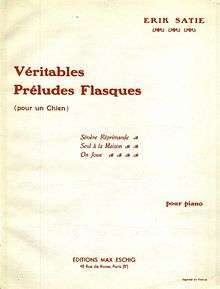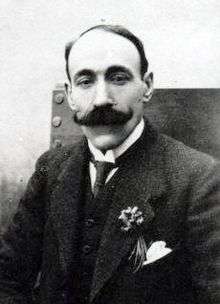Veritables Preludes flasques (pour un chien)
The Véritables Préludes flasques (pour un chien) (True Flabby Preludes for a Dog) is a 1912 piano composition by Erik Satie. The first of his published humoristic piano suites of the 1910s, it signified a breakthrough in his creative development and in the public perception of his music.[1][2] In performance it lasts about 5 minutes.
Satie biographer Rollo H. Myers, writing in 1948, remarked on the prophetic nature of this seemingly unassuming keyboard suite: "In the heyday of Impressionism...came the Flabby Preludes which in their linear austerity heralded the Neoclassic vogue which was to dominate Western music during the nineteen-twenties."[3]
Background
The Véritables Préludes flasques (pour un chien) represents Satie's determination to reconcile his belated education at the Schola Cantorum in Paris under Vincent d'Indy (1905-1912) with his own natural sense of wit and fantasy. It was in fact his second attempt at creating a composition on a canine theme, an idea that had long obsessed him.[4][5][6] In July 1912 Satie composed his piano suite Préludes flasques (pour un chien), but after it was rejected for publication by the Durand firm he informed his protégé Alexis Roland-Manuel that he was going to rewrite it from scratch.[7] The three pieces of the new set were completed between August 12 and August 23, 1912.[8] On September 13 Satie offered it to publisher E. Demets, who not only bought the work on the spot (for 50 francs) but asked for more.[9] This modest triumph convinced Satie that he was on the right creative path at last. On November 23, 1912, he formally ended his studies with d'Indy.[10] As Robert Orledge noted, "Once Satie could laugh at the Schola and himself he was back on course."[11] The Véritables Préludes flasques were published the following month. Unlike Durand, Demets saw commercial potential in the amusing novelty of the Préludes. The firm would publish 10 of Satie's humoristic piano suites over the next four years.
Music and texts

Despite Satie's description of them as "flabby", the three Véritables Préludes flasques (pour un chien) are lean, dry, and starkly contrapuntal:
- 1. Sévère réprimande (Severe Reprimand)
- 2. Seul à la maison (Home Alone)
- 3. On joue (We Play)
Composer Charles Koechlin observed that here Satie "gets rid of repetitions and redundancies. He prunes, throws out ballast, suppresses held notes, condenses, reduces the musical dialogue to a strict minimum."[12]
Biographer Pierre-Daniel Templier noted that "The novelty of the flabby preludes came as a charming surprise. Yet Satie's imagination is still kept in check here. Sévère réprimande, a lively and emphatic toccata with singing bass chords; Seul à la maison, a delightful two-part invention; On joue, with lightly bouncing fourths and fifths and minor sevenths climbing menacingly up the keyboard: no trace of humor here, in the music. But the directions are in mock Latin..."[13] These Latin directions include corpulentus (fat), epotus (drunken), caeremoniosus (ceremonially), paululum (tiny), opacus (shady) and, in a possible dig at d'Indy, paedagogus (schoolmaster).[14]
Performance

Satie dedicated the Véritables Préludes flasques (pour un chien) to pianist Ricardo Viñes, who gave the successful premiere of the work at a concert of the Société Nationale de Musique at the Salle Pleyel in Paris on April 5, 1913. The composer used this occasion to publish an advertisement announcing his future creative plans in that day's issue of the periodical Le Guide du concert. It is a mission statement of sorts, written in a high-handed tone calculated to bait his critics:
- "The Véritables préludes flasques...opens a series of pianistic works:
- Descriptions automatiques, Embryons desséchés, Chapitres tournés en tous sens and Vieux sequins et vieilles cuirasses.[15] In them I devote myself to the sweet joys of fantasy. Those who will not understand are requested by me to observe the most respectful silence and to show an attitude of complete submission and inferiority. That is their true role."[16]
Viñes would become the foremost champion of Satie's keyboard music through the early 1920s, premiering several of his compositions.[17] Satie was delighted by the "irresistibly droll air of secrecy" of his interpretations.[18] Viñes was also the piano teacher of Francis Poulenc, an important Satie protégé and future member of Les Six.
Recordings
Aldo Ciccolini (twice, in 1968 for Angel Records and 1988 for EMI); Frank Glazer (Vox, 1968, reissued 1990); Jean-Joël Barbier (Universal Classics France, 1971); William Masselos (RCA, 1968); Grant Johannesen (Vox, 1976); Yūji Takahashi (Denon, 1979); France Clidat (Forlane, 1984); Johannes Cernota (PolJazz, 1984); Roland Pöntinen (BIS, 1986); Jan Kaspersen (Olufsen Records, 1987); Anne Queffélec (Virgin Classics, 1988); Peter Dickinson (Classical Collection, 1990, reissued by Olympia, 2001); Joanna MacGregor (Collins Records, 1992); Gabriel Tacchino (Disques Pierre Verany, 1993); Jean-Pierre Armengaud (Circé, 1990, reissued 2000); Michel Legrand (Erato Records, 1993); Klára Körmendi (Naxos, 1993); Bojan Gorišek (Audiophile Classics, 1994); Olof Höjer (Swedish Society Discofil, 1996); Jean-Yves Thibaudet (Decca, 2003); Steffen Schleiermacher (MDG, 2005); Cristina Ariagno (Brilliant Classics, 2006); Alexandre Tharaud (Harmonia Mundi, 2009); Katia and Marielle Labèque (KML, 2009), Jeroen van Veen (Brilliant Classics, 2016).
References
- Pierre-Daniel Templier, "Erik Satie", MIT Press, 1969, pp. 81-82. Translated from the original French edition published by Rieder, Paris, 1932.
- Robert Orledge, "Satie the Composer", Cambridge University Press, 1990, p. 118.
- Rollo H. Myers, "Erik Satie", Dover Publications, Inc., NY, 1968, p. 128. Originally published in 1948 by Denis Dobson Ltd., London.
- Ornella Volta, "A Mammal's Notebook: The Writings of Erik Satie", Atlas Publishing, London, 1996 (reissued 2014), pp. 187-188. Volta believes Satie was inspired to dedicate a piece of music to a canine by one of his favorite books, Gargantua and Pantagruel by François Rabelais. In the preface to Gargantua, Rabelais paraphrased the ancient philosopher Socrates to urge readers to look beyond the "curious" titles of written works and explore their contents, just as a dog chews an unappetizing-looking bone to extract the marrow. Rabelais quotes from the same passage of Plato's Symposium that Satie would set to music in his cantata Socrate (1918).
- The idea stayed with Satie long after he had completed his sets of preludes pour un chien. He would later tell author Jean Cocteau, "I want to write a play for dogs, and I already have my set design: the curtain rises on a bone."See Ornella Volta, "Give a Dog a Bone: Some investigations into Erik Satie." Originally published as "Le rideau se leve sur un os" in the Revue International de la Musique Française, Vol. 8, No. 23, 1987. English translation by Todd Niquette. Retrieved from Niclas Fogwall's defunct Satie Homepage (1996-2014) through the Internet Archive Wayback Machine at https://web.archive.org/web/20041014172728/http://www.af.lu.se/~fogwall/articl10.html#sports07r.
- Dogs would also make whimsical appearances in the extramusical texts of Satie's piano suites Peccadilles importunes (1913) and Sports et divertissements (1914, in the piece Le Réveil de la Mariée).
- Erik Satie, letter to Alexis Roland-Manuel dated August 8, 1912. Quoted in Alan M. Gillmor, "Erik Satie", Twayne Publishers, Boston, 1988, p. 146.
- Robert Orledge, "Satie the Composer", Cambridge University Press, 1990, p. 296.
- Caroline Potter, "Erik Satie: A Parisian Composer and His World", Boydell & Brewer, 2016, p. 101.
- Steven Moore Whiting, "Satie the Bohemian: From Cabaret to Concert Hall", Clarendon Press, Feb 18, 1999, p. 359. Also see footnote 33 on same page.
- Robert Orledge, "Satie the Composer", Cambridge University Press, 1990, p. 120.
- Alexander Carpenter, Allmusic review at http://www.allmusic.com/composition/v%C3%A9ritables-pr%C3%A9ludes-flasques-pour-un-chien-truly-flabby-preludes-for-a-dog-for-piano-mc0002368379%3C
- Pierre-Daniel Templier, "Erik Satie", MIT Press, 1969, p.82. Translated from the original French edition published by Rieder, Paris, 1932.
- Complete score available at http://imslp.org/wiki/3_V%C3%A9ritables_pr%C3%A9ludes_flasques_(pour_un_chien)_(Satie%2C_Erik).
- Satie did not entirely adhere to this scheme. The unannounced suite Croquis et agaceries d'un gros bonhomme en bois was begun in June 1913 and intermittently worked on throughout the summer.
- Quoted in Ann-Marie Hanlon, "Satie and the Meaning of the Comic". Published as Chapter 2 in Dr Caroline Potter (ed.), "Erik Satie: Music, Art and Literature", Ashgate Publishing, Ltd., 2013, pp. 19-48.
- Templier, "Erik Satie", p. 35.
- Erik Satie, autobiographical blurb for publisher E. Demets' Bulletin des Editions musicales, December 1913. Quoted in Nigel Wilkins, "The Writings of Erik Satie", Eulenburg Books, London, 1980, p. 79.